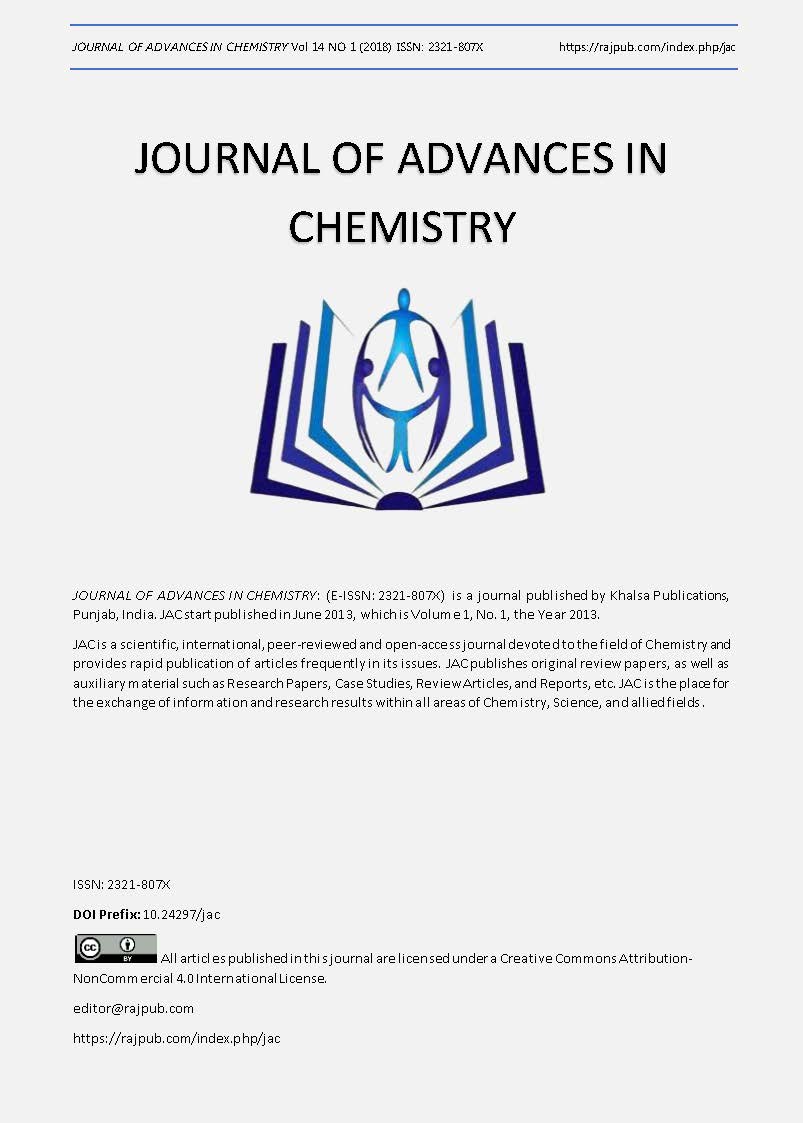Comparison Of Fe(II) And Fe(III)-Hydralazine Complexes, A Potentiometric And Spectrophotometric Studa
DOI:
https://doi.org/10.24297/jac.v14i1.6620Keywords:
Ferrous, ferric, hydralazine, complex, potentiometric study, spectrophotometric StudyAbstract
Iron in oxidation states (+2 and +3) is very essential element for human body, and its concentration significantly altered in cardio vascular disease. So the aim of the present work is to study the interaction of Fe(II) and Fe(III) with very commonly used antihypertensive drug hydralazine through potentiometric and spectrophotometric methods. The objectives of the work is to study the stoichiometry, behavior of the complexes in aqueous solution, effect of pH and behavior of this drugs towards both oxidation states of Iron. Both methods show that hydralazine forms a stable complex with both oxidation states of the metal, but the nature of complex changes with change in pH, ligand concentration and with time span. Both methods confirms 1:2 stoichiometry for Fe(II)-Hydralazine while 1:3 for Fe(III)-Hydralazine. Stabilities of both complexes were also calculated. For Fe(II)-Hydralazine complex values of log β1 and log β2 were found to be 4.99 and 7.58 respectively. For Fe(III)-Hydralazine complex log β1, log β2 and log β3 values were found to be 2.74, 7.39 and 11.32 respectively. At high ligand concentration hydralazine also show reducing properties. The study suggests a strong interaction of hydralazine with iron; however the nature of interaction is different with both oxidation states of iron.
Downloads
References
2. Bachschmid MM, Schildknecht S, Reiko Matsui, Rebecca Zee, Dagmar Haeussler, Richard A. Cohen, David Pimental, Bernd van der Loo, 2013, Vascular aging: Chronic oxidative stress and impairment of redox signaling—consequences for vascular homeostasis and disease, Ann. Med. 45(1), 17–36. DOI: 10.3109/07853890.2011.645498
3. Bahi GA, Bidie AP, Meite S, Djaman AJ, 2017, Exploring the iron metabolism in multidrug resistant tuberculosis (MDR-TB) patients in treatment, Int. J. Biol. Chem. Sci. 11(3), 1039-1045. DOI: https://dx.doi.org/10.4314/ijbcs.v11i3.9
4. Cohn JN, McInnes GT, Shepherd AM, 2011, Direct-Acting Vasodilators, J Clin Hypert., 13(9), 690–692, DOI: 10.1111/j.1751-7176.2011.00507.x
5. Eftekhari MH , Khosravi HM, Shidfar F, Zamani A, 2013. Relation between Body Iron Status and Cardiovascular Risk Factors in Patients with Cardiovascular Disease. Int J Prev Med. 4(8): 911–916. DOI:10.4103/2008-7802.182733
6. Jaffery GH, Bassett J, Mendham J, Denney RC, 1989, Vogel’s Text Book of Quantitative Chemical Analysis, Longman Scientific and & Technical, 5th edition, 292.
7. Imad S, Nisar S, Maqsood ZT, 2010, A study of Redox properties of Hydralazine Hydrochloride, an antihypertensive drug, J. Saud. Chem. Soc., 14, 241-245, DOI:10.1016/j.jscs.2010.02.003
8. Katherine, M.H., 2004, Vasodilators In Medical Toxicology, Richard, C.D., (Ed.), Lippincott Williams & Wilkins: Philadelphia, 3rd edition, 714-715
9. Machado JD, Gomez JF, Betancor G, Comacho M, Brioso MA, Borges Ricardo, 2002, Hydralazine Reduces the Quantal Size of Secretory Events by Displacement of Catecholamines From Adrenomedullary Chromaffin Secretory Vesicles, Circulation Res., (91), 830-836, DOI:org/10.1161/CIRCRESAHA.117.310812.
10. Murthy CP, Ali SFM, D Ashok, 2002, University Chemistry, 1, New Age International (P) Limited Publishers, India, 280.
11. Perveen, P, Naqui, II, The Nucleus, 41 (1-4), 63-6. 2
12. Petrucci RH, Harwood WS, Herring FG, Madura JD, 2007, Solubility and Complex Ion Equilibria: General Chemistry, Principles and Modern Applications, Pearson Education International: London, 9th edition, 762-763
13. Skoog DA, West DM, Holler FJ, Crouch SR, 2004, Potentiometry: Fundamentals of Analytical Chemistry, Thomson Books: Mexico, 623-627
14. Stephen JD, Elizabeths B, Monika H, Judson D, Russell NG, John K, Joseph AV. 2001, Iron Chelation Improves Endothelial Function in Patients With Coronary Artery Disease, Circulation, 103, 2799-2804. DOI:.org/10.1161/CIRCULATIONAHA.117.030114.
15. Thomas LL, David AW, 2012, Foye's Principles of Medicinal Chemistry, Seventh Edition, Lippincott Williams & Wilkins, Philadelphia, 781
Downloads
Published
How to Cite
Issue
Section
License
 All articles published in Journal of Advances in Linguistics are licensed under a Creative Commons Attribution 4.0 International License.
All articles published in Journal of Advances in Linguistics are licensed under a Creative Commons Attribution 4.0 International License.




